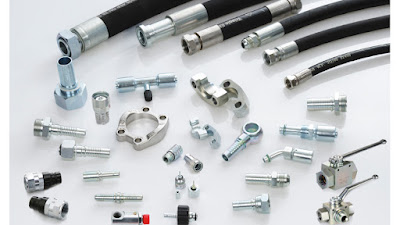Hydraulic fittings are a crucial component in any hydraulic system, playing a significant role in ensuring proper connectivity and fluid flow. When it comes to hydraulic systems, choosing the right type of fitting is of utmost importance to maintain efficiency, safety, and optimal performance.
In this comprehensive guide, we promise to provide an informative overview of common types of hydraulic fittings, their applications, and essential considerations for selecting the perfect fit for your specific requirements.
Understanding Hydraulic Fittings
Hydraulic fittings are specialised components designed to connect and terminate hydraulic lines, hoses, and tubes while ensuring a leak-free and secure connection. Hydraulic fittings facilitate the transmission of hydraulic fluid between different components of a hydraulic system, such as cylinders, valves, pumps, and motors. These fittings play a critical role in maintaining the integrity and efficiency of the hydraulic system.
When selecting hydraulic fittings, several key factors must be considered, including pressure rating, material compatibility, thread type, and environmental conditions. Understanding the function and importance of these factors is essential in making an informed decision when choosing the proper hydraulic fitting for your application.
Common Types of Hydraulic Fittings
A. Straight Fittings
Straight fittings are one of the most commonly used types of hydraulic fittings. These fittings are designed to create a straight connection between two hydraulic tubes or hoses. They are available in various sizes and configurations to accommodate different hydraulic system requirements. Straight fittings are typically used in applications where a direct, linear connection is needed to ensure efficient fluid flow.
Advantages of straight fittings include their simplicity, ease of installation, and compatibility with a wide range of hydraulic components. However, they may have limitations in applications that require complex routing or where space constraints are a concern.
B. Elbow Fittings
Elbow fittings, also known as bend fittings, are designed to change the direction of fluid flow within a hydraulic system. These fittings feature angled connections, allowing for a change in the orientation of hydraulic tubing or hoses. Elbow fittings are commonly used in applications where space limitations or specific routing requirements necessitate a change in direction without creating kinks or excessive stress on the hydraulic lines.
The benefits of using elbow fittings include their ability to facilitate complex hydraulic system layouts, reduce the need for additional tubing, and minimise the risk of line failure due to improper bending. However, it is essential to consider the potential limitations of elbow fittings, such as increased flow resistance in specific configurations and the need for proper alignment during installation.
C. Tee Fittings
Tee fittings are designed to create a T-shaped connection within a hydraulic system, allowing for hydraulic lines or hoses to branch. These fittings enable the seamless integration of multiple components into a single hydraulic circuit, making them ideal for applications that require the distribution of hydraulic fluid to different locations.
The advantages of tee fittings lie in their ability to simplify hydraulic system design, facilitate the connection of multiple components, and enable efficient fluid distribution. However, it is essential to consider potential drawbacks, such as increased space requirements and the need for proper support to prevent stress on the connections.
Choosing the Right Hydraulic Fitting for Your Needs
Several factors must be considered when selecting the proper hydraulic fitting for your specific needs. Understanding the application requirements, pressure ratings, material compatibility, and environmental conditions is crucial in ensuring the optimal performance and longevity of the hydraulic system.
A detailed review of application requirements: Before choosing a hydraulic fitting, it is essential to conduct a thorough review of the specific application requirements, including the operating pressure, temperature, flow rate, and environmental factors. This information will help determine the most suitable type of fitting for the intended purpose.
Pressure rating, material compatibility, and other essential considerations: The pressure rating of a hydraulic fitting must be compatible with the operating pressure of the hydraulic system to prevent leaks or failures. Additionally, considering the material compatibility with hydraulic fluids, environmental conditions, and the intended service life of the fittings is vital in making an informed selection.
Tips for Proper Maintenance and Installation
Proper maintenance and installation practices ensure the longevity and reliability of hydraulic fittings within a hydraulic system.
Best practices for installation: When installing hydraulic fittings, it is crucial to follow the manufacturer's guidelines and recommendations for proper assembly, torque values, and use of sealants or thread compounds. Ensuring a secure and leak-free connection is paramount to the overall performance of the hydraulic system.
Guidelines for maintenance: Regular inspection and maintenance of hydraulic fittings are necessary to identify and address potential issues such as leaks, corrosion, or wear. Implementing a proactive maintenance schedule can help prevent unexpected failures and downtime.
Tips to extend the lifespan of hydraulic fittings: Taking proactive measures such as using protective covers, implementing proper routing and support for hydraulic lines, and avoiding excessive vibration or shock loads can contribute to extending the lifespan of hydraulic fittings and maintaining the overall integrity of the hydraulic system.
Conclusion
In conclusion, the selection and proper installation of hydraulic fittings are critical to ensuring hydraulic systems' efficiency, safety, and longevity. By understanding the common types of hydraulic fittings, their applications, advantages, limitations, and essential considerations for selection, individuals and businesses can make informed decisions to meet their specific hydraulic system requirements.
Choosing the proper hydraulic fitting and implementing best practices for maintenance and installation are critical factors in establishing a solid and reliable hydraulic system for various industrial, mobile, and agricultural applications.
As you embark on selecting hydraulic fittings from reputable providers like Austfluid Link for your needs, we hope this guide has provided you with valuable insights and knowledge to make informed decisions. Remember, the suitable hydraulic fitting can make all the difference in the performance and reliability of your hydraulic system.
























